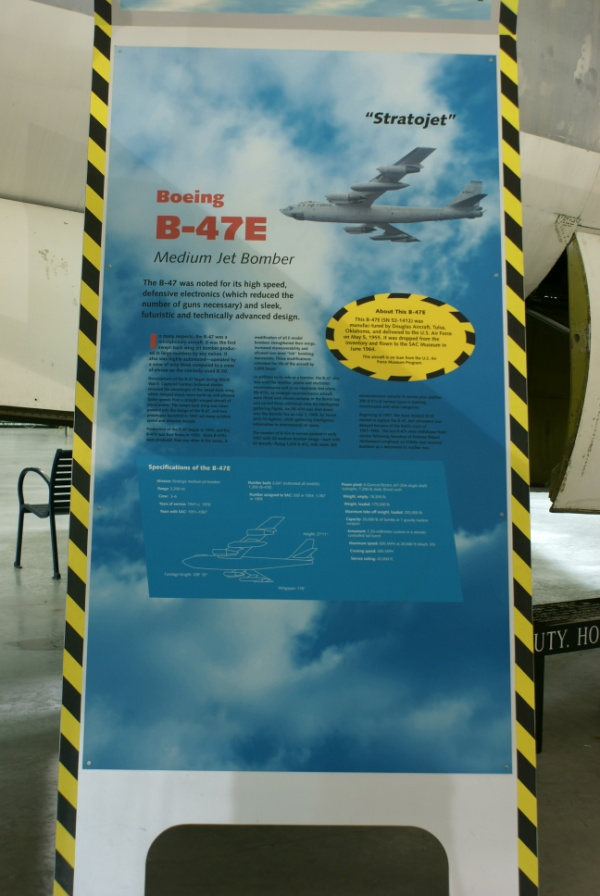| Prev |
heroicrelics.org Strategic Air Command & Aerospace Museum Site Index B-47 Gallery |
Next |
dsc44607.jpg
The sign accompanying the aircraft. It reads
"Stratojet"
Boeing
B-47E
Medium Jet BomberThe B-47 was noted for its high speed, defensive electronics (which reduced the number of guns necessary) and sleek, futuristic and technically advanced design.
In many respects, the B-47 was a revolutionary aircraft. It was the first swept-back wing jet bomber produced in large numbers by any nation. It was also highly automated -- operated by a crew of only three compared to a crew of eleven on the similarly-sized B-50.
Development of the B-47 began during World War II. Captured German technical studies revealed the advantages of the swept-back wing, which delayed shock-wave build-up and allowed faster speeds than a straight-winged aircraft of equal power. The swept-back wing was incorporated into the design of the B-47, and two prototypes launched in 1947 set many aviation speed and distance records.
Production of the B-47 began in 1950, and the B-47E was first flown in 1952. More B-47Es were produced than any other in the series. A modification of all E-model bombers strengthened their wings, increased maneuverability, and allowed low-level "lob" bombing maneuvers. These modifications extended the life of the aircraft by 3,000 hours.
In addition to its role as a bomber, the B-47 also was used for weather, photo and electronic reconnaissance and as an electronic test plane. RB-47Es, as strategic reconnaissance aircraft, were fitted with eleven cameras in the bomb bay and carried three additional crew for intelligence gathering flights. An RB-47H was shot down over the Barents Sea on July 1, 1960 by Soviet MiG-15 fighters while gathering intelligence information in international air space.
The number of B-47s in service peaked in early 1957 with 28 medium bomber wings -- each with 45 aircraft -- flying 1,260 B-47s, with some 300 reconnaissance variants in service plus another 300 B-47s of various types in training, maintenance and other categories.
Beginning in 1957, the more modern B-52 started to replace the B-47, but retirement was delayed because of the Berlin crisis of 1961-1962. The last B-47s were withdrawn from service following Secretary of Defense Robert McNamara's emphasis on ICBMs over manned bombers as a deterrent to nuclear war.
About This B-47E
This B-47E (SN 52-1412) was manufactured by Douglas Aircraft, Tulsa, Oklahoma, and delivered to the U.S. Air Force on May 5, 1955. It was dropped from the inventory and flown to the SAC Museum in Jun 1964.
This aircraft is on loan from the U.S. Air Force Museum Program.
Specifications of the B-47E
Mission: Strategic medium jet bomber
Range: 3,200 mi
Crew: 3-6
Years of service: 1947-c. 1976
Years with SAC: 1951-1967
Number built: 2,041 (estimated all models), 1,350 (B-47E)
Number assigned to SAC: 265 in 1954, 1,367 in 1958
Height: 27' 11"
Fuselage length: 109' 10"
Wingspan: 116'
Power Plant: 6 General Electric J47-25A single-shaft turbojets, 7,200-lb static thrust each
Weight, empty: 78,200 lb
Weight, loaded: 175,000 lb
Maximum take-off weight, loaded: 202,000 lb
Capacity: 20,000 lb of bombs or 1 gravity nuclear weapon
Armament: 2 20-millimeter cannon in remote-controlled tail turret
Maximum speed: 650 MPH at 20,000 f 9mach .93)t
Cruising speed: 495 MPH
Service ceiling: 42,000 ft

| Time picture taken | Sun Jul 27 14:11:22 2008 |
| Location picture taken |
Hangar A Strategic Air & Space Museum Ashland, NE |
| Prev |
heroicrelics.org Strategic Air Command & Aerospace Museum Site Index B-47 Gallery |
Next |